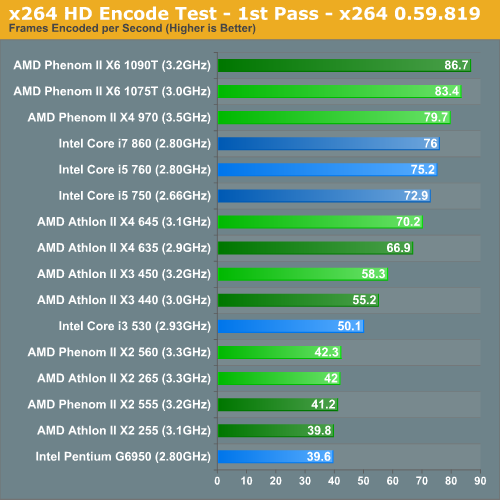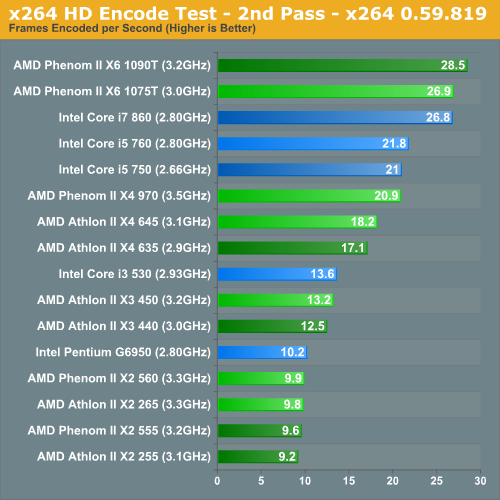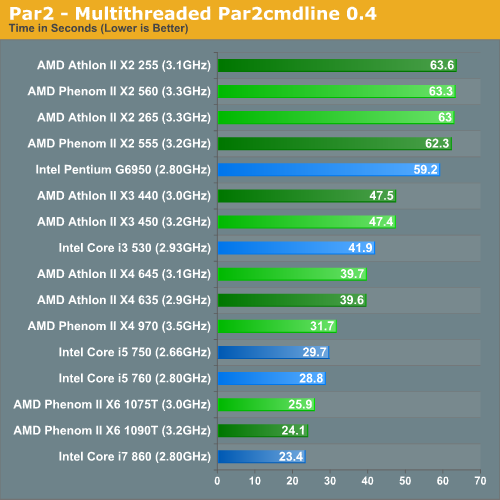AMD's Fall Refresh: New Phenom II and Athlon II CPUs Balance Price and Performance
by Anand Lal Shimpi on September 21, 2010 2:52 AM EST- Posted in
- CPUs
- AMD
- Phenom II X6
- Athlon II
x264 HD Video Encoding Performance
Graysky's x264 HD test uses x264 to encode a 4Mbps 720p MPEG-2 source. The focus here is on quality rather than speed, thus the benchmark uses a 2-pass encode and reports the average frame rate in each pass.


Video encoding performance is a definite strength of the Phenom II X6. You get comparable performance to the more expensive Core i7 860. And without Hyper Threading, the Core i5s are unable to distance themselves from the Phenom II X4 970.
Again the Athlon II X4 645 and X3 450 dominate their respective competitors.
PAR2 Multithreaded Archive Recovery Performance
Par2 is an application used for reconstructing downloaded archives. It can generate parity data from a given archive and later use it to recover the archive
Chuchusoft took the source code of par2cmdline 0.4 and parallelized it using Intel’s Threading Building Blocks 2.1. The result is a version of par2cmdline that can spawn multiple threads to repair par2 archives. For this test we took a 708MB archive, corrupted nearly 60MB of it, and used the multithreaded par2cmdline to recover it. The scores reported are the repair and recover time in seconds.

The direct comparisons we've been pointing out this entire match continue to hold as we look at different applications. The Phenom II X6 1075T performs as it should, while the Phenom II X4 970 falls short of the i5 750. The triple and quad-core Athlon IIs couldn't be better.
7-Zip Benchmark Performance
Included in 7-zip is a pure algorithm test that completely removes IO from the equation. This test scales with core count and as a result we get a good theoretical picture of how these chips perform. Note that the actual 7-zip compression/decompression process is limited to 2 threads so there's no real world advantage to having more cores.











98 Comments
View All Comments
IceDread - Tuesday, September 21, 2010 - link
Annoying to see that we still have no competition in the high end segment. It's still being dominated by intel which makes for higher prices for us, the consumers.Dark_Archonis - Tuesday, September 21, 2010 - link
Annoying? Well it is what it is, AMD just can't compete at the high end and I don't think Bulldozer will help much going up against Sandy Bridge E.Madmanden - Wednesday, September 22, 2010 - link
Well that's a surprise...mino - Tuesday, September 21, 2010 - link
Well, I think we are a bit spoiled actually.Just think about it for a minute - had not AMD acquired an almost complete DEC team around 1997, there would have been NO real competition and the prices would WAY above what Intel is charging now.
Think VIA Nano on steroids as "competition".
Let's be realistic, shall we?
It is simply not feasible for 2 competitors in such a complex field to be BOTH on top concurrently for extended periods of time (as has happened during the Slot A heydays).
These situations are bound to be more of an abnormality than a standard.
Considering the HUGE gap in resources, we shall be very happy that AMD is still within 30% of Intel's TOP despite using an 12yrs old K7 architecture.
A true testament to Alpha actually.
And, for killing IA64 on desktop alone, they deserve a Nobel prize! No contest.
Dark_Archonis - Wednesday, September 22, 2010 - link
Speaking of Alpha, I wonder where many former Alpha employees have gone? Oh right, they're now working at Intel on future Itanium processors.Sure we were spoiled, if you will, years ago when AMD introduced the K7, Intel missed with the P4, and AMD introduced the K8.
Thing is, historically Intel was almost always on top in the consumer CPU market.
AMD did provide some real competition back then, but not so much anymore. Intel can price AMD out of existence right now if they wanted to, but Intel doesn't want to.
Unless Bulldozer is a gigantic performance leap forward, AMD will continue to struggle to provide competition and will only be "good enough" or barely catching up to Intel's latest.
Intel has real competition in non-consumer markets, and that is challenging Intel.
crucibelle - Wednesday, September 22, 2010 - link
fanboi.Dark_Archonis - Wednesday, September 22, 2010 - link
I love such thorough and insightful answers such as these.People talk all the time about how competition is good. Real competition is good yes, mediocre or weak competition is almost pointless. Right now AMD is mediocre/weak competition from Intel.
You can call people names, point fingers, and complain about it all day long, but it is what it is.
I have nothing against seeing some STRONG competition for Intel, but AMD currently isn't providing strong competition.
bji - Wednesday, September 22, 2010 - link
Really? Then why did I decide to buy a 1075T instead of an Intel chip in the same price range? For my needs (all of my single threaded apps are quite fast enough with any modern processor, but as a software developer I need as many cores as I can get for parallel compiles) the 1075T is a great deal. Throw in the fact that AMD motherboards are better than Intel at the same price point and it was an easy decision. I am slightly miffed that Bulldozer won't be AM3 compatible becase I was banking on that a little but when deciding to go with an AMD platform, but whatever. The rest of the value proposition is still in AMD's favor.Now of course my experience is just anecdotal; I can say with certainty that in some segments, AMD is very competitive with Intel. I think the question of whether or not AMD provides "strong competition" with Intel is really just about how many segments AMD provides strong competition with Intel and how strong the competition is in those segments, and from that, you can decide whether or not the overall competition is "strong" or "weak".
Given the success AMD is having in netbooks/notebooks lately (at least all of the Fry's/Best Buy/Office Depot/whatever ads I have seen in the past few months have been heavily featuring AMD, I assume because the platform is selling well), I think we can say that AMD is providing strong competition in that space.
In the 'midrange' CPU market - which is the majority of the PC processor market - AMD clearly provides strong competition. See this Anandtech article, my purchasing decision above, countless similar articles and testimonies all over the internet.
On the high end PC CPU market, AMD is not competitive. We all know that.
On the server CPU front, AMD has not been competitive lately but is starting to gain a little ground back. At least, if my impressions given what I've read on Anandtech and other sites is anything to go by.
So in the end, I'd say that in 3 out of 4 x86 CPU markets, AMD is providing strong competition with Intel. For this reason I think it's erroneous to call AMD's current competitiveness 'weak'. I think it's overall 'fairly strong', and I only hope it gets stronger, for everyone's benefit.
bji - Wednesday, September 22, 2010 - link
Oh and I forgot to mention integrated graphics. Of course AMD is extremely competitive with Intel in that segment, and in fact is the dominating player (at least, performance-wise).flyck - Wednesday, September 22, 2010 - link
AMD is competing with Intel just fine.Yes they have problems when Conroe was launched in the high end. Most of this is due to the problems they encountered with Barcelona. Without those issues they would have been very competive with Core2. i7 lineup is now the strongest technology but AMD can compete ok using more cores. The biggest issue AMd is having is that most of their products had to be postponed. But with Ontario platform they will have their first real low power chip which is very promesing. llano will offer higher speed than x4 with very good GPU, which again is a pretty solid effort to gain the low and mainstream market due to embedded graphics that do not suck for desktop useage. Bulldozer, although to late, seems to be a chip on which AMD can build further upon. Performance is one area, the ability to price competitive is also an area and that is an area AMD is really competing with. Their future shows alot of promise (bit like in the K8 days where the XP couldn't cut it anymore). AMd is the only reason why Intel (lead x86 manufacturer) is actually making processor worth the money. This alone implies that AMD is competitive with Intel. Without the clausules and market abuse iItel did in teh years before, K7 and K8 could have damaged them alot more, they can't let that happen again.